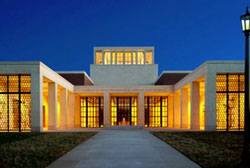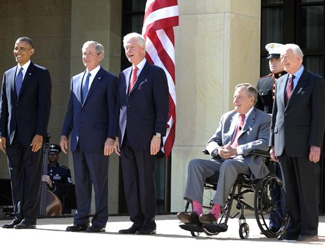redo Jump to...
print Print...
 (by Colleen McCain Nelson, The Wall Street Journal) UNIVERSITY PARK, Texas – Former President George W. Bush, dedicating the library and museum that will house his presidential records, on Thursday said he stayed true to his core convictions during his time in the White House by lowering taxes, raising school standards and leaving foreign countries liberated from dictators.
(by Colleen McCain Nelson, The Wall Street Journal) UNIVERSITY PARK, Texas – Former President George W. Bush, dedicating the library and museum that will house his presidential records, on Thursday said he stayed true to his core convictions during his time in the White House by lowering taxes, raising school standards and leaving foreign countries liberated from dictators.
The dedication of the George W. Bush Presidential Center on the campus of Southern Methodist University [in Dallas] highlighted the 43rd president’s resolve after Sept. 11, his work in Africa and his good humor, with only passing references to the controversial decisions that marked his two terms in office.
Mr. Bush said that as president, his deepest-held conviction was that America must strive to expand the reach of freedom.
“One of the benefits of freedom is that people can disagree,” Mr. Bush said, adding that he created plenty of opportunities for people to exercise that right.
The opening of Mr. Bush’s library and museum has prompted an examination of his administration, as Bush allies have argued that with the benefit of time, many of the former president’s actions would be viewed more objectively and positively.
The library itself invites debate and discussion, with interactive displays and theater that allows visitors to walk through four key decision points that Mr. Bush faced and then weigh in with what they would do.
 Thursday was the rare occasion that brought together five U.S. presidents: Mr. Bush; his father, George H.W. Bush; Barack Obama; Bill Clinton; and Jimmy Carter. The event also drew an array of leaders from around the world; members of Congress, including House Speaker John Boehner (R., Ohio); several governors, including New Jersey’s Chris Christie; and a who’s who of Bush administration officials. [Also in attendance were former heads of state including former Prime Ministers Tony Blair of Britain, Ehud Olmert of Israel and Silvio Berlusconi of Italy as well as Spanish President Jose Maria Aznar.]
Thursday was the rare occasion that brought together five U.S. presidents: Mr. Bush; his father, George H.W. Bush; Barack Obama; Bill Clinton; and Jimmy Carter. The event also drew an array of leaders from around the world; members of Congress, including House Speaker John Boehner (R., Ohio); several governors, including New Jersey’s Chris Christie; and a who’s who of Bush administration officials. [Also in attendance were former heads of state including former Prime Ministers Tony Blair of Britain, Ehud Olmert of Israel and Silvio Berlusconi of Italy as well as Spanish President Jose Maria Aznar.]
It was an emotional event for father and son as the two former presidents appeared on stage together, the elder Bush rising from his wheelchair to stand next to his son for a moment. The courtyard in the museum features statues of the two Bush presidents standing side by side.
“It is awesome that you are here today,” Mr. Bush said to his father.
The five living presidents had gathered only once before, at the White House in 2009 after Mr. Obama was elected. …On Thursday, they highlighted the positive and made light of their disagreements. …
President Obama has been among Mr. Bush’s most vocal and persistent critics, blaming his predecessor for the financial crisis he inherited. But on Thursday, he praised Mr. Bush’s willingness to reach across the aisle and his work to rewrite immigration laws – an effort that Mr. Obama vowed to complete.
“Every president gains a greater appreciation for all those who served before him, for the leaders from both parties who have taken on the momentous challenges and felt the enormous weight of a nation on their shoulders,” Mr. Obama said. “And for me, that appreciation very much extends to President Bush.”
Mr. Clinton didn’t hesitate to poke fun at Mr. Bush, joking about the 43rd president’s new hobby of painting…
Mr. Clinton also nodded in jest to the challenge every president faces in defending his legacy, calling the library the “latest, grandest example of the eternal struggle of former presidents to rewrite history.”
When it was Mr. Bush’s turn to speak, he said that “when future generations come to this library and study this administration, they’re going to find out that we stayed true to our convictions – that we expanded freedom at home by raising standards in schools and lowering taxes for everybody – that we liberated nations from dictatorship and freed people from AIDS and that when our freedom came under attack, we made the tough decisions required to keep the American people safe.”
Mr. Bush, who wiped tears from his eyes as he finished his remarks, called Thursday a happy day as he looked across the crowd of family and friends who came to celebrate his library.
“Beautiful building has my name above the door, but it belongs to you,” he said. “It honors the cause we serve and the country we share.”
[“I dedicate this library with an unshakable faith in the future of our country,” Bush said, noting that he had “the honor of a lifetime to lead a country as brave and as noble as the United States. Whatever challenges come before us, I will always believe our nation’s best days lie ahead. God bless.”]Copyright 2013 Dow Jones & Company, Inc. All Rights Reserved. Reprinted here for educational purposes only. Visit the website at wsj.com.
Questions
1. Where is the George W. Bush Presidential Library and Museum located?
2. List the presidents who attended the dedication of President Bush’s Library and Museum.
3. What accomplishments did President Bush point out were made by his administration during his time in office?
4. From where does President Bush say our freedom comes?
5. Read the “Background” about the Presidential Library system. Which president initiated the practice of the presidential libraries?
6. Visit the website for the George W. Bush Library (also linked to under “Resources” below). The news report relates in para. 7: “The library itself invites debate and discussion, with interactive displays and theater that allows visitors to walk through four key decision points that Mr. Bush faced and then weigh in with what they would do.” Is this a good way to help visitors gain a better understanding of President Bush’s key decisions? Explain your answer.
Background
The Presidential Library system:
- The Presidential Library system is composed of thirteen Presidential Libraries.
- These facilities are overseen by the Office of Presidential Libraries, in the National Archives and Records Administration.
- Presidential Libraries are not libraries in the usual sense. They are archives and museums, bringing together in one place the documents and artifacts of a President and his administration and presenting them to the public for study and discussion without regard for political considerations or affiliations.
- Presidential Libraries and Museums, like their holdings, belong to the American people.
- During his second term in office, President Franklin D. Roosevelt surveyed the vast quantities of papers and other materials he and his staff had accumulated.
- In the past, many Presidential papers and records had been lost, destroyed, sold for profit, or ruined by poor storage conditions. President Roosevelt sought a better alternative.
- On the advice of noted historians and scholars, he established a public repository to preserve the evidence of the Presidency for future generations.
- Beginning a tradition that continues to this day, he raised private funds for the new facility and then turned it over to the United States government for operation through the National Archives. (from archives.gov/presidential-libraries/about)
Resources
Visit the George W. Bush Presidential Library and Museum website at: georgewbushlibrary.smu.edu.
Presidential Libraries present vast archives of documents, museums full of important Presidential artifacts, interesting educational and public programs, and informative web sites. Visit the National Archives page on Presidential Libraries at: archives.gov/presidential-libraries.
Watch the beginning of the April 25th ceremony:
On April 24th, members of the press were given a tour of the library.
Watch an Associated Press (AP) report:
Daily “Answers” emails are provided for Daily News Articles, Tuesday’s World Events and Friday’s News Quiz.



